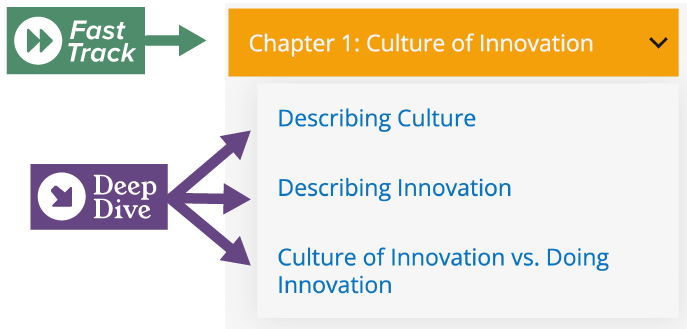

This is a Deep Dive page. Select the chapter for the Fast Track
Assessing the Maturity of Your Culture of Innovation
Your culture of innovation program's progress and growth can be demonstrated by a maturity model. In The Collaborative Organization, Jacob Morgan creates a five-step maturity model for building a collaborative organization.1 And the research completed for this WebResource uncovered that a collaborative culture is very closely aligned with an innovative one. Furthermore, several of the case study interviewees demonstrated that their culture of innovation had grown from their culture of collaboration.
Chapter 2 demonstrates how innovation can be driven into an airport's culture through five organizational elements (leadership, staff, strategy & policy, organizational structure, and process & procedure). It also introduces the mindset individuals need in order to spark innovative change in an organization. Once many people in an organization take on this mindset, it becomes the culture's mindset.
Building on all of these concepts, Figure D8.1 presents a five-step maturity model to evaluate your culture of innovation.

Figure D8.1: Five-Step Maturity Model for Building a Culture of Innovation.
- Unaware. Leaders and staff do not see the value of an innovative culture. Typically, managers are most unwilling to change at this stage, as they are uncertain and fearful of how innovation will impact the organization. Cultural mindset: The culture is neutral or not open to change or new ideas, and it may even be fearful of change.
- Exploratory. Leaders and staff research how a culture of innovation can affect the organization. They begin to try innovation and see how it can solve problems. Ad hoc teams may start forming to drive this innovation into the airport. Some risk-averse business functions, like legal and procurement, will be the most resistant at this point. A strategic direction also starts taking shape in this stage of maturity. Cultural mindset: The culture is more open to change and experimentation than the unaware mindset.
- Defined. Leaders clearly define an innovative strategic plan and determine whether organizational structure needs to change to support the new strategy. Leaders are getting ready to communicate and share the new vision; roles and teams are more clearly defined. New ideas are documented, and measures of success are defined. Strategic and structural framework changes are complete, and the organization is ready to begin implementing. Cultural mindset: The culture is more open to change and experimentation than the exploratory mindset.
- Adoptive. A formal culture of innovation team is established, the strategy and vision are communicated, measures of success are established, risks are evaluated, procedures are developed, and feedback is collected. Staff are the most resistant because they are expected to try new things. Morale improves as staff begin to more clearly understand their roles and get to know others better. Trust grows among staff members, and they see ways to engage and inspire others. The organization starts retaining and attracting new talent. Cultural mindset: The culture is experimental, open to change, collaborative, inspired by others' successes, and seeking feedback.
- Adaptive. This is a continuous state of improvement and evolution. This type of organization can easily regress if it does not listen to employees and incorporate their feedback. Employees must be supported and listened to so that they will continue to focus on learning, collaborating, exploring, and seeking feedback. Employees know that things will always change and they need to try out new procedures and strategies. They let go of what does not work and focus on what does, so the organization improves. Problems continue to be solved, and successes are repeated. The organization becomes more efficient, productive, and adaptive. Morale continues to improve as staff find that they have a voice and leaders listen to it. Cultural mindset: The culture is experimental, open to change, collaborative, inspired by others' successes, seeking feedback, resisting a mindset of failure, learning from setbacks, and accountable.
This model shows how far your culture of innovation program can take you if your organization supports and enables it. Make it a habit to occasionally refer to this model as you assess where your organization currently stands, areas where progress has been nurtured, and areas that need more tending or pruning.


1 Jacob Morgan, The Collaborative Organization, p. 219, McGraw Hill (New York, NY), 2012, https://thefutureorganization.com/books/.

